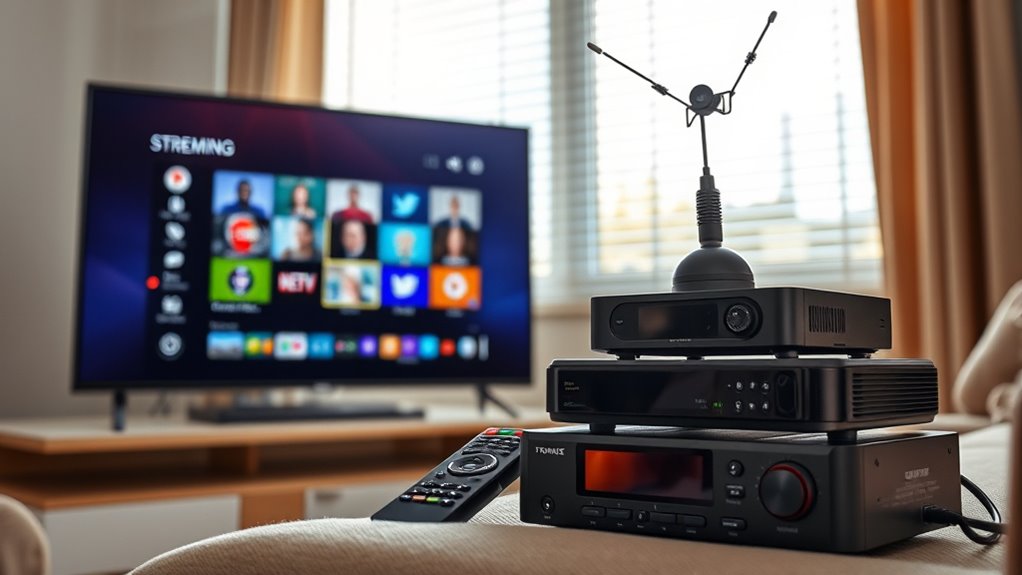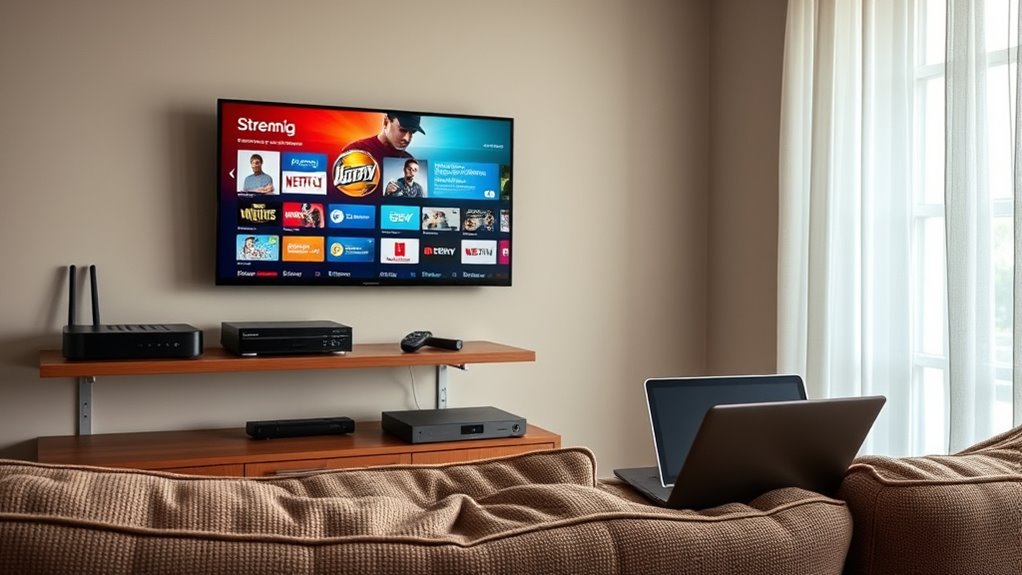If you want the cheapest way to watch TV, antennas are your best option since they offer free access to local channels without ongoing fees. Streaming services cost less than cable, but high-speed internet is needed, making monthly expenses comparable. Cable offers the most channels but usually involves contracts and higher costs. To learn more about cost-saving options and features, keep exploring your best TV solution.
Key Takeaways
- Antennas are the cheapest option with free local channels after a one-time purchase, no ongoing fees.
- Streaming services are more affordable than cable, often costing $5-$20/month, but require high-speed internet.
- Cable TV is typically the most expensive, exceeding $80/month, with contracts and additional fees.
- Combining antenna with streaming offers a low-cost way to access local channels and on-demand content.
- Overall, antennas and basic streaming plans are the most cost-effective options for watching TV.

Choosing the right way to watch TV depends on your budget, preferences, and viewing habits. If you’re trying to find the most affordable option, it’s vital to evaluate subscription costs and channel variety. Cable TV, for example, has seen prices steadily climb, with typical bundles that combine TV and internet often exceeding $80 per month before taxes and fees. This makes cable a costly choice for many households. Streaming services usually start cheaper, with basic plans costing between $5 and $20 a month. However, if you want live TV streaming options, expect to pay $45 to $85 or more monthly, depending on the package and extras included. Keep in mind, streaming also requires high-speed internet, which adds around $50 monthly, making the total cost comparable to or sometimes less than cable, especially if you limit your subscriptions.
Evaluating costs and channel options helps you choose the most affordable TV viewing method.
Antennas provide the cheapest way to watch TV since they offer free access to local broadcast channels like ABC, CBS, NBC, and FOX. After the initial equipment purchase, there are no monthly fees, making antennas an excellent choice for budget-conscious viewers. But remember, antennas only give you access to local stations, so you miss out on cable’s extensive channel lineup and streaming’s wide content variety. Cable offers a significant advantage with its broad range of live channels, including sports, local stations, and premium networks, providing a diverse channel lineup that appeals to many viewers. Streaming services like YouTube TV, Hulu + Live TV, or Sling TV deliver between 30 and over 200 channels, including major networks and niche content, though local channel coverage can vary by area.
When it comes to flexibility, streaming services shine. They typically operate on a month-to-month basis, with no long-term contracts or cancellation fees, allowing you to upgrade, downgrade, or cancel easily. Cable often involves lengthy contracts, early termination fees, and bundled internet requirements, which can add to the cost and inconvenience. Antennas have no ongoing fees or contracts but lack features like on-demand content and multi-device streaming. Streaming also offers multiple simultaneous streams and on-demand access, while cable provides DVR options, but may impose usage caps or hidden fees such as equipment rental. Furthermore, streaming services are continually updating their offerings, giving viewers access to the latest content and features without waiting for cable upgrades.
In addition, understanding how contrast ratio impacts picture quality can help you choose a better viewing setup, especially when considering different connection types and content sources. Ultimately, choosing the most economical way to watch TV depends on balancing your budget with your desire for channel variety, quality, and convenience.
Frequently Asked Questions
How Does Internet Speed Affect Streaming Quality?
Your internet speed directly impacts streaming quality by influencing bandwidth allocation. If your speed is too low, you’ll experience internet buffering, disrupting your viewing experience. Insufficient bandwidth can cause automatic quality reduction or interruptions, especially with higher resolution videos like 4K. To avoid these issues, make certain your connection provides enough bandwidth for your chosen streaming quality, and reduce the number of devices sharing the network during streaming.
Can I Combine Streaming, Cable, and Antenna Services?
You can absolutely combine streaming, cable, and antenna services—it’s like building a TV powerhouse! Bundled packages make this easy, offering cost savings and a wide channel variety. Just check service compatibility to guarantee all devices work smoothly together. You’ll enjoy local channels with an antenna, cable’s premium content, and streaming’s flexibility—all in one setup. This approach gives you tailored entertainment without breaking the bank.
What Are the Hidden Costs of Each TV Option?
When comparing costs and service limitations, you find hidden expenses with each option. Streaming can drain your budget with frequent price hikes, unused subscriptions, and account sharing fees. Cable often sneaks in equipment, installation, and regional surcharges, raising your bill unexpectedly. Antennas involve upfront costs and potential upgrades due to signal issues. Carefully assess these hidden costs to determine the most affordable, reliable choice tailored to your viewing needs.
How Reliable Is an Antenna During Bad Weather?
You might think antennas are unreliable in bad weather, but with proper maintenance, they can still perform well. Heavy storms, rain, and wind can weaken signals or cause damage, affecting reliability. Regular antenna maintenance, like securing it properly and weatherproofing, helps mitigate weather impact. While extreme weather can disrupt reception temporarily, a well-maintained antenna and strategic placement ensure your signal stays strong during most storms.
Are There Any Legal Restrictions on Using Free Streaming Apps?
When using free streaming apps, you need to be aware of copyright concerns and geographic restrictions. These apps must have proper licenses for the content they offer; otherwise, you’re risking legal trouble. Also, many apps use geolocation controls to comply with regional licensing laws. If you bypass these restrictions or access content illegally, you could face fines or other penalties. Always make certain you’re using licensed, regionally permitted streaming services to stay within the law.
Conclusion
Ultimately, choosing the cheapest way to watch TV depends on your needs. Streaming offers flexibility, cable provides variety, and antennas are budget-friendly. Remember, “You get what you pay for,” so weigh your options carefully. If cost is your main concern, antennas might be your best bet. But if you want convenience and more channels, streaming or cable could be worth the investment. Make your choice wisely, and enjoy your favorite shows without breaking the bank.










